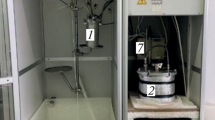Abstract
A lipophilic hollow fiber membrane preparation was used for the enzymatic glucuronidation of lipophilic aromatic compounds. A crude solubilized microsomal enzyme preparation was circulated on the external side of the lipophilic membrane while the phenol containing buffer solution was circulated through the internal side of the hollow fiber membrane. Phenols, which accumulate in and penetrate the lipophilic membrane, were converted by UDP-glucuronyltransferase to the corresponding glucuronides. During this process the lipophilic compounds are converted to hydrophilic substances, which are not able to rediffuse through the lipophilic membrane into the donor side of the hollow fiber module. The produced glucuronide is separated by means of a coupled dialysis with a module of hydrophilic surface (cellulose acetate), while the enzyme protein is retained.
On the stripping side of the dialysing module the glucuronide can be separated by solid phase extraction (Lichroprep RP-18) while a continuous substitution of cofactor into this compartment is possible. UDPGA follows its own concentration gradient and migrates into the enzymatic mixture, where it is utilized. This new technique using hollow fiber modules offers completely new possibilities for long-term high-capacity, highly specific glucuronidation of phenolic compounds. Fields of application are not only the economical production of special glucuronides, but also the specific elimination of phenols from waste fluids or from serum and blood of patients.
For the production of glucuronides by this technique the use of highly purified enzymes is not essential. Cheap crude enzyme preparations are quite adequate for an optimal reaction. Using a crude enzyme preparation with a specific batch activity of 13 nMol/min per mg of protein, the activity in the reactor system was observed to be 4.6 nMol/min of 2-naphtol glucuronide formed per mg of protein. This corresponds to 3.6 nMol/h of product formed per mg of protein per cm2 of hollow fiber surface.
Using a membrane surface of 0.5 m2 the production of 18 mMol of glucuronide per h and mg protein can be achieved.
Similar content being viewed by others
References
Storey, I. D. E.: The synthesis of glucuronides by tissue slices. Biochem. J. 47 (1950) 212–222
Dutton, G. J.; Storey, I. D. E.: Glucuronide synthesis in liver homogenates. Biochem. J. 48 (1951) 29
Bock, K. W.; Fröhling, W.: UDP-glucuronyltransferase activity in isolated perfused rat liver. Naunyn Schmiedebergs Arch. Pharmacol. 283 (1974) 319–330
Burchell, B.: Observations of uridine diphosphate glucuronyltransferase activity towards oestriol and xenobiotics in developing and cultures tissues from mouse and man. Biochem. Soc. Trans. 1 (1973) 1212–1214
Mulder, G. J.: Heterogeneity of uridine diphosphate glucuronyltransferase from rat liver. Biochem. J. 125 (1971) 9–15
Back, P.; Spaczynski, K.; Gerok, W.: Bile salt glucuronides in urine. Hoppe Seylers Z. Physiol. Chem. 355 (1974) 749–752
Blanckaert, N.; Gollan, J.; Schmid, R.: Bilirubin diglucuronide synthesis by a UDP-glucuronic acid dependent enzyme system in rat liver microsomes. Proc. Natl. Acad. Sci., Washington, 76 (1979) 2037–2041
Matern, H.; Matern, S.; Shelzig, Ch.; Gerok, W.: Bile acid UDP-glucuronyltransferase from human liver, FEBS Letters 118 (1980) 251–254
Brunner, G.; Jaworeck, D.: A new approach towards an extracorporeal management in liver failure: Use of detoxifying enzymes bound to artificial membranes. In: Leevy, C. M. (Ed.): Diseases of the liver and biliary tract. Basel: S. Karger 1976, pp. 39–41.
Lösgen, H.; Brunner, G.; Holloway, C. J.; Büttelmann, B.; Husmann, S.; Scharff, P.; Siehoff, A.: Large agarose beads for extracorporeal detoxification systems. 1. Preparation and some properties and applications of the large beads in haemperfusion. Biomat. Med. Dev. Artif. Org. 6 (1978) 151–173
Brunner, G.; Holloway, C. J.; Lösgen, H.: Large agarose beads for extracorporeal detoxification systems. 2. Preparation and enzymatic properties of agarose-bound UDP-glucuronyltransferase. Int. J. Artif. Organs 2 (1979) 163–169
Brunner, G.; Tegtmeier, F.: Enzymatic detoxification using lipophilic hollow fiber membranes. I. Glucuronidation reactions. Artif. Organs 82 (1984) 161–166
Holloway, C. J.: Isotachophoresis applied to the study of complex enzymatic reactions involving uridine nucleotides. Fresenius Z. Anal. Chem. 301 (1980) 136
Holloway, C. J.; Husmann-Holloway, S.; Brunner, G.: Assay of UDP-glucuronyltransferase with mixtures of acceptors using analytical capillary isotachophoresis. Electrophoresis 2 (1981) 25–31
Holloway, C. J.; Husmann-Holloway, S.; Brunner, G.: New method for the quantitative assay of the enzymatic hydrolysis of UDP-glucuronic acid using analytical capillary isotachophoresis. J. Chromatogr. 188 (1980) 235–245
Parikh, J.; MacGlashan; Fengelau, G.: Immobilized glucuronyltransferase for the synthesis of conjugates. J. Med. Chem. 19 (1976) 296–299
Ripperger, S.; Schulz, G.: Microporous membranes in biotechnical application. Bioprocess Eng. 1 (1986) 43–49
Author information
Authors and Affiliations
Rights and permissions
About this article
Cite this article
Tegtmeier, F., Belsner, K. & Brunner, G. Enzymatic synthesis of glucuronides using lipophilic hollow fiber membranes. Bioprocess Engineering 3, 43–47 (1988). https://doi.org/10.1007/BF00372859
Received:
Issue Date:
DOI: https://doi.org/10.1007/BF00372859




